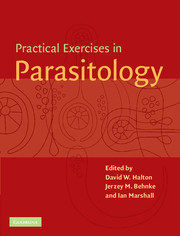Book contents
- Frontmatter
- Contents
- List of contributors
- Preface
- General advice
- 1 Observational Exercises on Parasites
- A Local wild and domestic hosts as sources of parasites
- 1.1 Parasites of the earthworm: Monocystis (Protozoa) and Rhabditis (Nematoda)
- 1.2 Parasites of marine molluscs (Littorina)
- 1.3 Parasites offish: (a) Whiting and Diclidophora merlangi (Monogenea)
- 1.4 Parasites of fish: (b) Plaice/flounder and Lepeophtheirus pectoralis (Copepoda)
- 1.5 Parasites of domestic livestock: (a) Pig and Ascaris suum (Nematoda)
- 1.6 Parasites of domestic livestock: (b) Sheep and Fasciola hepatica (Trematoda)
- 1.7 Parasites of crops: Potato cyst nematode (PCN) Globodera pallida (Nematoda)
- B Laboratory maintained species
- 2 Ecology
- 3 Physiology and Biochemistry
- 4 Pathology and Immunology
- 5 Chemotherapy
- 6 Molecular Parasitology
- 7 Behaviour
- Appendix 1 Reagent index
- Appendix 2 UK suppliers
- Appendix 3 US suppliers
- Index
1.7 - Parasites of crops: Potato cyst nematode (PCN) Globodera pallida (Nematoda)
Published online by Cambridge University Press: 05 June 2012
- Frontmatter
- Contents
- List of contributors
- Preface
- General advice
- 1 Observational Exercises on Parasites
- A Local wild and domestic hosts as sources of parasites
- 1.1 Parasites of the earthworm: Monocystis (Protozoa) and Rhabditis (Nematoda)
- 1.2 Parasites of marine molluscs (Littorina)
- 1.3 Parasites offish: (a) Whiting and Diclidophora merlangi (Monogenea)
- 1.4 Parasites of fish: (b) Plaice/flounder and Lepeophtheirus pectoralis (Copepoda)
- 1.5 Parasites of domestic livestock: (a) Pig and Ascaris suum (Nematoda)
- 1.6 Parasites of domestic livestock: (b) Sheep and Fasciola hepatica (Trematoda)
- 1.7 Parasites of crops: Potato cyst nematode (PCN) Globodera pallida (Nematoda)
- B Laboratory maintained species
- 2 Ecology
- 3 Physiology and Biochemistry
- 4 Pathology and Immunology
- 5 Chemotherapy
- 6 Molecular Parasitology
- 7 Behaviour
- Appendix 1 Reagent index
- Appendix 2 UK suppliers
- Appendix 3 US suppliers
- Index
Summary
Aims and objectives
This exercise is designed to demonstrate:
The biology of plant parasitic nematodes.
The complexity of the host-parasite relationship in these organisms.
Introduction
Plant parasitic nematodes are serious pests of agricultural crops throughout the world. The nematodes cause damage directly to the crop plant and may also act as vectors for plant viruses. The chemicals used to control plant parasitic nematodes are amongst the most toxic applied to the soil but, as yet, other ways of controlling these parasites are not commercially viable. Some plant parasitic nematodes are classified as migratory ectoparasites; these are soil dwellers which simply feed on roots with which they come into contact. Others, including the most economically important species (the root knot and cyst forming nematodes), are sedentary endoparasites and have far more complex life cycles.
An example of a sedentary endoparasite is the potato cyst nematode (PCN) Globodera pallida. This nematode has an intimate relationship with its host. Cysts, each of which contains 2-300 eggs, lie dormant in the soil until the second stage juveniles (J2) within the eggs (the moult from J1 to J2 occurs in the egg) are stimulated to hatch by the presence of potato root diffusates. After hatch, the J2 locates and enters the growing host root, usually just behind the zone of elongation. It then migrates intracellularly until it reaches the differentiating vascular cylinder tissue, where it sets up a feeding site.
- Type
- Chapter
- Information
- Practical Exercises in Parasitology , pp. 63 - 72Publisher: Cambridge University PressPrint publication year: 2001



